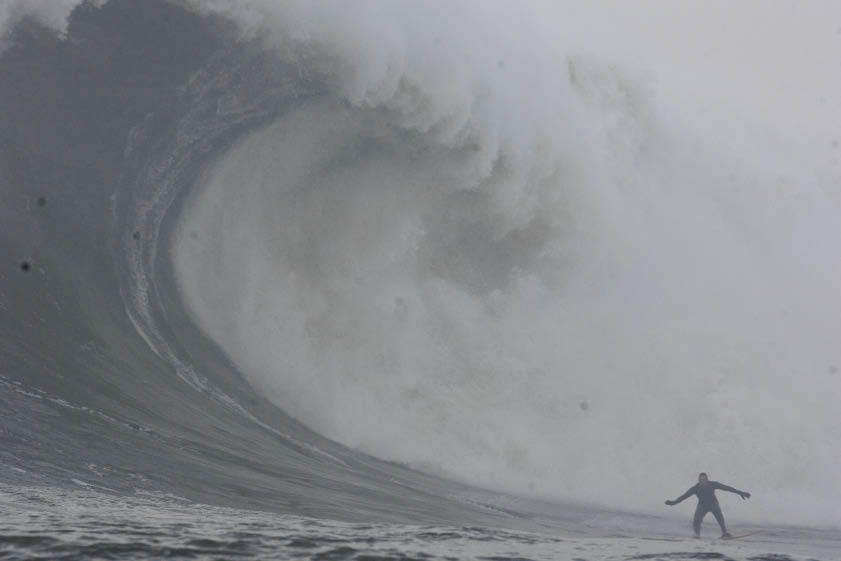Atlantic by Simon Winchester and The Wave by Susan Casey are, at first glance, very different works. Atlantic is a historical-philosophical-fantastical meditation on the Atlantic ocean, from the ‘post-molten Hadean’ through the ‘cool meadows of today’s Holocene’, to the conjectured end-days of the ocean ‘about 170 million years’ from now. The Wave is a pithy account of some years Casey spent following the elite American surfer Laird Hamilton as he travelled from one storm-lashed coast to another in search of waves. Yet, on closer scrutiny, the two books have much in common: both authors are highly contemporary in the way they write about nature, with their mingling of humility and eschatology; both suggest that we have half-ruined the oceans they describe; both squint nervously into the darkness of the future.
‘In Victorian times,’ Winchester explains, ‘we thought of the ocean as vast and frightening: we still regarded it with some kind of awed respect. Not any more.’ Now, the Atlantic is ‘changing under the malign influence of landsmen so utterly careless of the sea.’ For much of his book, Winchester pays entertaining homage to the traditional sagas of the sea: Vikings, pirates, explorers, naval victories and disasters, slave ships, Moby Dick, Atlantic civilisations, U-boat attacks during two world wars, pioneering flights above the ocean. There are gripping diversions into memoir: the time Winchester was nearly engulfed by tides on a barren Atlantic beach, or nearly shipwrecked off the Western Cape, or nearly frozen in the remote North. For Winchester
the Atlantic ocean is surely a living thing — furiously and demonstrably so. It is an ocean that moves, impressively and ceaselessly. It … is forever roaring, thundering, boiling, crashing, swelling, lapping . . .
Yet, in the final third of his book, Winchester becomes less glittering and anecdotal. The tone becomes even admonitory:
One cannot but hang one’s head in shame and abject frustration: we pollute the sea, we plunder the sea, we disdain the sea . . . forgetting or ignoring all the while that the sea is the source of all the life on earth, the wellspring of us all. The Atlantic, first to be found, to be crossed, and to be known, is by far the most polluted, the most plundered, the most disdained, the most dishonoured of the world’s oceans.
The jaunty sub-headings become laced with sardonic irony: ‘Up she rises’ introduces a section devoted to global warming and the melting of the ice. The mythical sea monsters are swept aside by the still more monstrous blankness of the Greenlandic ice cap, now haemorrhaging melt water into the sea. ‘The Atlantic’s problems will become the world’s problems in very short order,’ writes Winchester, imagining the future destruction of major coastal cities: New York’s subways filled with floodwater; London smashed apart by storms; Rotterdam submerged entirely, or forced to float its buildings on an ever-rising sea.
The Wave is equally driven by a sense of foreboding. Casey writes:
Anyone who lives on this planet is utterly dependent on its oceans. Their temperatures and movements control the weather; their destructive — and life-giving — ability dwarfs anything on land. Now that climate change is an accepted fact with unknown consequences, our vulnerability is sinking in. As the waters heat up … polar ice and glaciers melt, causing sea levels to rise. How far will they rise?
A decade or so ago, Casey might have crafted her surf-quest book without so much as a nod to environmental concerns or the reports of climate scientists. Yet her book displays and discusses a changed culture of nature-writing and the fantasies we entertain about nature. One hundred-foot waves, the cultish preoccupation of surfers, were formerly regarded as one more myth of the sea, whispered of by wide-eyed shipwreck survivors, refuted by so-called men and women of science. Yet, in recent years, 100-foot waves have been calibrated by high-tech ocean-monitoring equipment. One scientist tells Casey, ‘until two years ago we were laughed at because we did waves … It’s a combination of factors all coming together.’
Like Winchester, Casey muses on the prospect of future storms, floods, ever more capricious and destructive seas. She consults authorities, finds them with their heads bowed before the mysteries of the ocean: wave scientists ‘struggling to understand how [waves] work’; rescue experts describing the sea as a ‘place where the unknown happens’; veteran surfers explaining that ‘not to behave with humility … was the ultimate karmic sin’. All the surfers she interviews, even Laird Hamilton, ‘had survived rag-doll wipe-outs on massive faces. They knew what it felt like to be pummelled by the waves …’ Their accounts are ritually pantheistic, worshipful: ‘Laird’s on the face and the reef is drained off and there’s this THING behind him. And I saw it! I saw it. I saw the Big Mother.’
Both books are eloquent and absorbing. Even if one doubts some of the projections of climate modelling, as Winchester clearly does; even if one suspects that all theories must be queried, that we can never be blithely certain about what is happening around us, let alone in some predicted future, it’s hard to resist such warnings against hubris. Who wants to be the crazy freak who tempts the fates, only to get washed away by a tsunami? Better, surely, to listen to your inner surfer…






Comments